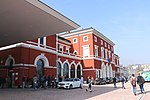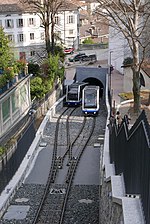Old Church of Santa Lucia, Massagno

The old Church of Santa Lucia in Massagno, canton of Ticino, Switzerland, was built in the 16th century and demolished in 1931 because of the extension of the Via San Gottardo. The new parish church of Santa Lucia was built to replace it in 1931 a few hundred metres from the square of the old church."The year of construction is not clearly indicated... An element for [its] determination...can be taken from the picture of the Adoration of the Magi...created by Bernardino Luini (or under his direction by his pupils) around the middle of the 16th century as a fresco above the altar." The frescoes and paintings from the old church, some from the 16th century, are now in the new church, including the 16th-century fresco of the Adoration of the Magi, which was transferred to canvas, and the paintings of the Annunciation (1636) and of Santa Lucia (17th century).
Excerpt from the Wikipedia article Old Church of Santa Lucia, Massagno (License: CC BY-SA 3.0, Authors, Images).Old Church of Santa Lucia, Massagno
Via Bernardino Stazio, Circolo di Vezia
Geographical coordinates (GPS) Address Nearby Places Show on map
Geographical coordinates (GPS)
| Latitude | Longitude |
|---|---|
| N 46.0107 ° | E 8.9465 ° |
Address
Via Bernardino Stazio
6900 Circolo di Vezia
Ticino, Switzerland
Open on Google Maps







